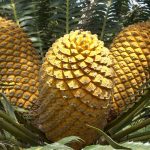 Seed plants in which the ovules or seeds are not enclosed in an ovary (e.g. cycads, ginkgo, gnetums, yews and conifers).
Seed plants in which the ovules or seeds are not enclosed in an ovary (e.g. cycads, ginkgo, gnetums, yews and conifers).
Refers to a group of vascular plants in which the seed is not protected by an ovary or fruit. Pines, firs, and cycads belong to this group.
Major clade of seed plants in which the developing ovules and seeds are produced in a cone-like structure and not enclosed in an ovary but rather are produced nakedly.
Woody plants that produce seeds but no flowers and no true fruits. Developing seeds are produced on the scales of woody, occasionally fleshy, cones. Include cycads, pines (conifers), and cypresses. (Compare Angiosperm).
Plants bearing naked seeds, that is, not enclosed in a fruit, and without true flowers. The gymnosperms are now seen as representing an evolutionary level rather than a group that evolved from a single ancestor; they first appeared in the Palaeozoic era, at least 100 million years before the first flowering plants. The largest living group of gymnosperms is the conifers, followed by the cycads. Other small relic groups are the ginkgo, the ephedras, the gnetums, and the amazing Welwitschia.
